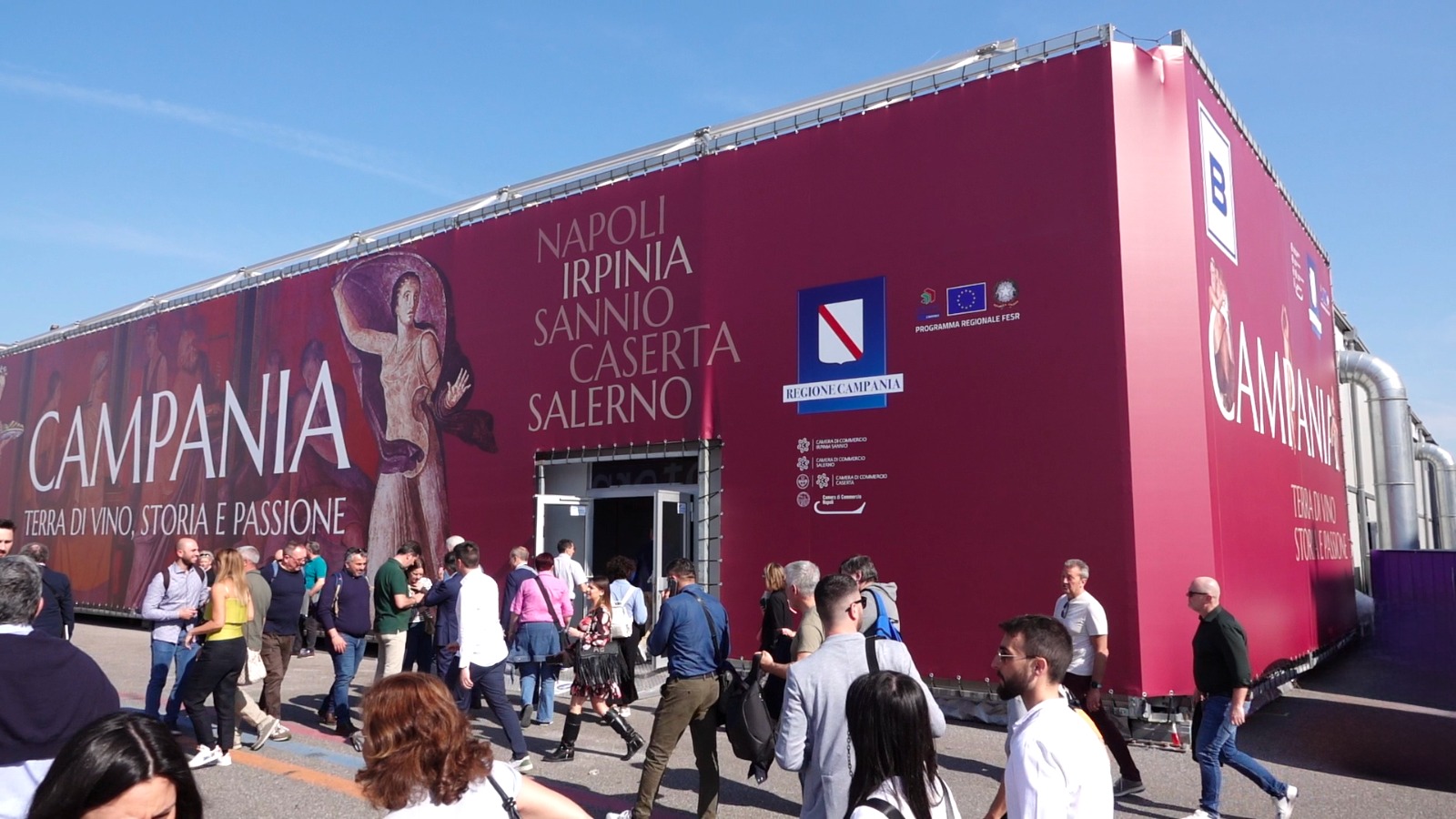Campania is present at the 56th edition of Vinitaly – in Verona from 14 to 17 April 2024 – with a group of over 180 companies selected by the Region, coming from the territory of ‘Campania divino’.
The Campania pavilion – an area of 5800 square metres, the second space set up at the fair after the Veneto hosts – is managed by the Department of Agriculture and the Department of Production Activities of the Region, in collaboration with the four Chambers of Commerce (Naples, Caserta, Salerno, Irpinia and Sannio).
Over 2000 labels on the stands of the Campanian companies divided into five distinct corridors based on the production territories: Irpinia, Sannio, Salerno, Caserta and Naples.
Great collaboration between all the territories, summarised in the regional wine shop where the regional PDOs and PGIs proposed by the 7 Consortia for the Protection of Wines (Vitica, Irpinia, Sannio, Vita Salernum Vites, Vesuvius, Campi Flegrei and Ischia, Sorrento Peninsula) were offered for tasting to the public in a continuous formula, with the support of specialist sommeliers from Ais Campania.
“A great Vinitaly for Campanian companies” was the comment of the Councillor for Agriculture Nicola Caputo who, during the inaugural day, recorded “the liveliness of producers and the quality of wine production” commenting positively on the presence of “many young people and many women representing production companies”.
An important detail also for Andrea Prete, national president of UnionCamere and of the Salerno Chamber of Commerce, who stressed the importance of the contribution that the Chamber of Commerce system and the Campania Region ensure to participate in a strategic event where, through products, an entire territory is promoted. And the opportunities for growth mean job opportunities which, for the region with the youngest population in Italy, means reducing emigration and the depletion of human capital. Another moment of growth for the territory will be, according to Prete, the opening, in July, of Salerno airport. "A great opportunity for Campania - he said - the only large region that had only one stopover and a "fundamental infrastructure for the development not only of tourism but of all sectors".
The Chamber of Commerce system has focused heavily on Vinitaly. The Irpinia Sannio Chamber of Commerce has also organised an off-show event.”Irpinia & Sannio Wine Nightto enhance the value of local wine products and holdings.
Teamwork has enabled the Campania Region to successfully participate in the international wine and spirits fair, as highlighted by Luciano D’Aponte, Head of Agri-food Promotion – Department of Agriculture – of the Campania Region, who, in reporting in numbers the presence at Vinitaly 2024, highlighted the collaboration between the agri-food sector and that of regional production activities, anticipating the upcoming events at the Sial in Paris and in Munich for B2Bs.
This commitment is also reflected in the words of Raffaella Farina, Director-General for Economic Development and Productive Activities of the Campania Region, who explained how, through the use of European funds from the 2021-2027 cycle, the Campania Region is supporting the Campania entrepreneurial system so that it is increasingly innovative, sustainable and open to international contexts. "The value of Campania's exports is worth 12 billion, which can be increased by another 8 billion according to ICE data," he said. The sectors for which Campania is known in the world are different: fashion, aerospace, but certainly Agrifood for all".
Agrifood, internationalization, but also innovation at Vinitaly for the development of the entrepreneurial system of Campania. This is the case of the observation and sensor system developed through joint work carried out by experts in aeronautical and space technology with winegrowers and presented by Luigi Carrino, President of the Campania Aerospace District, during the conference ‘Stories of the future’. This is possible thanks to the creation of a regional innovation ecosystem, developed as part of the Campania Region’s Smart Specialisation Strategy, which involves the scientific and industrial worlds.
A profound dialogue with the world of research, entrepreneurship and agrifood was also witnessed by the rector of Federico II University, Matteo Lorito, who not only recalled the Avellino site dedicated to oenology and viticulture, but also the role of Federico II in the great National Centre for Technologies in Agriculture: Agritech. And then, ‘cherry on the cake’ – Lorito recalls – Federico II today expresses the President of the International Organisation of Wine and Vineyards, Professor Luigi Moio of the Department of Agriculture.’ On the occasion of the 800th anniversary of the University of Naples ‘Federico II’, Professor Moio, together with Professor Luigi Frusciante, held a conference at the Campania pavilion at Vinitaly entitled ‘Wine between past and future’.
And from the past, from a tradition that has become an Intangible Cultural Heritage of Humanity (UNESCO), came further confirmation of the infinite possibilities for development linked to the wine sector. This is the case of the “Greenhouse of Windmill’, an Aglianico PGI Paestum, cultivated with Pollica, as part of a redevelopment project of the municipal administration led by Stefano Pisani, which has recovered an abandoned land of about 20 hectares. The Mediterranean diet is one of the assets of the Integrated Program of Enhancement of the Cilento coast South which, with the coordination of the Campania Region and the support of the European cohesion policy, aims to define a set of works dedicated to small Cilento municipalities.
The history of wine in the Mediterranean diet shows how strong the relationship between wine and the community is, as underlined by Carlo Marino, President of Anci Campania and Mayor of Caserta, according to whom ‘the importance of food and wine combined with the cultural heritage sector can be an opportunity not only for economic GDP, but for social GDP. For a territory, wine is an opportunity and a possibility. In this respect, our companies must increasingly bring together the identity, land, land, community and history of one people.”




